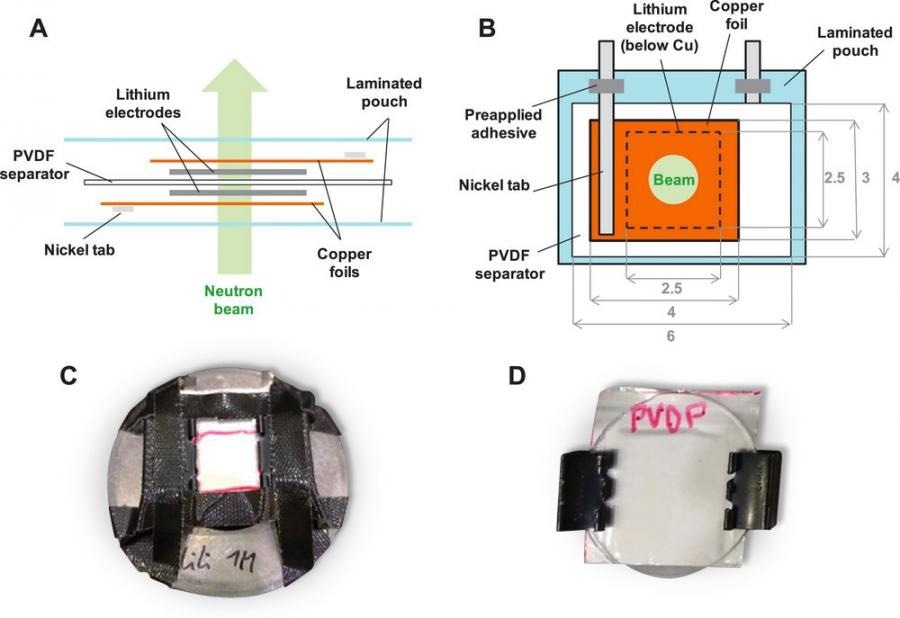A group of scientists from ANSTO, under the leadership of Professor Vanessa Peterson, employed neutron scattering techniques to investigate the development of problematic lithium structures in rechargeable lithium-ion batteries (LIBs).
 In situ cell construction. Image Credit: ANSTO
In situ cell construction. Image Credit: ANSTO
The study was published in Advanced Energy Materials.
While lithium-ion batteries are commonly used in portable electronics and electric vehicles, their energy storage capacity often falls short of the demands posed by emerging next-generation technologies.
Substituting the typical electrodes in these batteries with pure lithium metal can significantly enhance energy storage. However, the formation of lithium microstructures at the lithium surface can result in short circuits and potentially lead to catastrophic battery failures.
It is important to understand how and why these detrimental lithium structures form in order to prevent them from forming, and ultimately enable us to use these types of higher energy batteries.
Vanessa Peterson, Professor, ANSTO
In dismantled batteries, various types of structures have been observed, including “whiskers,” “moss,” and “dendrites.” Whiskers appear as small needle-like formations, moss resembles a porous layer, and dendrites form long, thin structures. Among these structures, it is the “pointy” dendrites that pose the most significant challenges and issues.
We used small-angle and ultra-small-angle neutron scattering (SANS and USANS) techniques with our Quokka and Kookaburra instruments at the Australian Centre for Neutron Scattering to study these complex lithium structures.
Vanessa Peterson, Professor, ANSTO
Professor Vanessa Peterson emphasized the significance of these methods due to their ability to offer insights into the size and shape of the lithium structures within a battery without disassembly. Given that a battery comprises various components, the research team gathered SANS and USANS data from different parts of the battery to specifically isolate the information related to lithium. This approach enables a focused analysis of lithium structures without disassembling the battery.
“This information helped us design a symmetrical pouch cell that was ideal for studying the changes in the lithium that gets deposited inside it,” Vanessa Peterson adds.
The researchers employed SANS and USANS as a more accurate and straightforward approach for analyzing the structure of deposited lithium, as opposed to other techniques such as X-Ray imaging, microscopy, or gas adsorption.
The study further demonstrated that SANS and USANS were highly sensitive to forming interfaces between the lithium and the electrolyte during lithium deposition.
Professor Peterson utilized mathematical models to quantitatively assess the surface area and the average distance between these interfaces, using data obtained from the measurements.
We observed that the surface area and interfacial distances of deposited lithium change in complex ways depending on the history of the battery's use.
Vanessa Peterson, Professor, ANSTO
“This research opens the door for future investigations to explore how factors like the amount of electric current, charging time, and the cyclic process of lithium deposition and dissolution impact the surface area and the distances between interfaces within deposited lithium. Understanding these factors is crucial for addressing the challenges associated with lithium dendrite growth in LMB technology,” she adds.
ANSTO contributors include first author energy materials specialist Dr Christophe Didier (who completed a contract at ANSTO), Prof Elliot Gilbert, and A.Prof Jitendra Mata.
ANSTO's specialized capabilities and expertise in materials analysis for energy applications consistently yield valuable insights into the field of batteries.
Journal Reference:
Didier, C., et al. (2023). Direct In Situ Determination of the Surface Area and Structure of Deposited Metallic Lithium within Lithium Metal Batteries Using Ultra Small and Small Angle Neutron Scattering. Advanced Energy Materials. doi.org/10.1002/aenm.202301266.